Last month’s posting covered the popular methods for sensing AC current (shunt, current transformer, Hall sensor, Rogowski coil). Here we will review some of the instruments available for fixed, portable, local and remote AC measurements.
 Fixed applications usually involve a meter mounted in a panel or enclosure. The current sensing element may be housed within the meter or mounted externally. Self-contained digital ammeters typically use an internal shunt and are either average or rms responding. Many are specified for 50/60Hz operation, with direct measurement up to 2 amps. Higher currents require an external current transformer (see below). Wider bandwidth models are available. For example, the Simpson F35 3½ digit meter (left) has a 50-1kHz bandwidth. The 4-digit Trumeter APM (center) has BW to 400Hz. The Laurel Laureate 5½ digit meter (right), with 10Hz-10kHz bandwidth, is suitable for high accuracy, audio and distorted waveform measurements.
Fixed applications usually involve a meter mounted in a panel or enclosure. The current sensing element may be housed within the meter or mounted externally. Self-contained digital ammeters typically use an internal shunt and are either average or rms responding. Many are specified for 50/60Hz operation, with direct measurement up to 2 amps. Higher currents require an external current transformer (see below). Wider bandwidth models are available. For example, the Simpson F35 3½ digit meter (left) has a 50-1kHz bandwidth. The 4-digit Trumeter APM (center) has BW to 400Hz. The Laurel Laureate 5½ digit meter (right), with 10Hz-10kHz bandwidth, is suitable for high accuracy, audio and distorted waveform measurements.
Analog AC Ammeters
Analog AC ammeters use either a taut band movement for rms measurement or a rectifier circuit for average response with rms calibration. Some models can handle up to 30 amps using an internal resistor. For higher currents, transformer-rated ammeters are calibrated for use with an external CT.
Three-phase power and energy meters measure AC current for the calculation of kW, VA and kWh.These meters usually have a small, internal CT on each phase to isolate the current inputs from the meter’s measuring circuits. Some include data logging capability, storing periodic readings in internal memory.
AC Current Transformers
Instrumentation grade current transformers are available in a wide variety of current and power (VA) ratings. The typical output is either 1A or 5A AC full scale, with accuracy specified for 50/60Hz. Both solid core and split-core styles are available, with the latter popular on retrofit applications. CTs require a meter with an AC current input. A few models include an internal shunt resistor to convert the output to a low-level AC voltage, which is then measured by an AC voltmeter. While these models may look identical to amp output units, the meter can be located further from the CT without degrading accuracy. The resistor also eliminates the shock hazard from an open secondary. See other blog postings for CT sizing and selection information.
AC Current Transducers
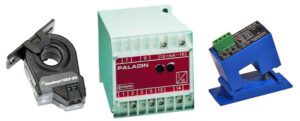 AC current transducers combine a current transformer with signal conditioning to provide a proportional DC output signal. Typical output levels are 0-5V, 0-10V and 4-20mA, which simplifies connection to a remote meter, controller or computer system. The signal conditioning may be externally powered or self-powered, average sensing or true RMS sensing. A typical example is the Veris H822 (left), which is available in solid and split-core styles. The Crompton Paladin (center) is suitable for DIN rail mounting. Accuracy for both products is specified at 50 or 60Hz. Some models, like the NK Technologies ATPR-E (right), extend to 400Hz for use on SCR controls and variable frequency drives.
AC current transducers combine a current transformer with signal conditioning to provide a proportional DC output signal. Typical output levels are 0-5V, 0-10V and 4-20mA, which simplifies connection to a remote meter, controller or computer system. The signal conditioning may be externally powered or self-powered, average sensing or true RMS sensing. A typical example is the Veris H822 (left), which is available in solid and split-core styles. The Crompton Paladin (center) is suitable for DIN rail mounting. Accuracy for both products is specified at 50 or 60Hz. Some models, like the NK Technologies ATPR-E (right), extend to 400Hz for use on SCR controls and variable frequency drives.
Digital Multimeter
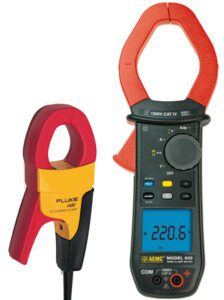 Portable AC current measurements can be made with a variety of handheld instruments. The most popular is the digital multimeter. Many handheld DMMs include an AC amps function. Internally these meters use the shunt measurement method, with ranges from milliamps up to 2 or 20 amps. A bandwidth of 45-500Hz is typical. TRMS models will generally have somewhat higher bandwidth to capture harmonics of line frequency signals. Resolution varies from 3½ to 5½ digits. For higher currents or to avoid breaking the circuit to insert the meter, an accessory clamp can be used with the DMM. One example is the Fluke I400 (left), which measures up to 400A. A one-piece solution is the digital clamp meter. The typical clamp meter has an integral jaw that functions as a split-core current transformer. Clamp meters rated up to 3000A, such as the AEMC 603 (right), are available from multiple manufacturers. A few models also offer clamp measurements with microamp sensitivity. Since some clamp meters also measure DCV, ACV, DCA, and ohms, they can often replace a DMM in the service toolkit.
Portable AC current measurements can be made with a variety of handheld instruments. The most popular is the digital multimeter. Many handheld DMMs include an AC amps function. Internally these meters use the shunt measurement method, with ranges from milliamps up to 2 or 20 amps. A bandwidth of 45-500Hz is typical. TRMS models will generally have somewhat higher bandwidth to capture harmonics of line frequency signals. Resolution varies from 3½ to 5½ digits. For higher currents or to avoid breaking the circuit to insert the meter, an accessory clamp can be used with the DMM. One example is the Fluke I400 (left), which measures up to 400A. A one-piece solution is the digital clamp meter. The typical clamp meter has an integral jaw that functions as a split-core current transformer. Clamp meters rated up to 3000A, such as the AEMC 603 (right), are available from multiple manufacturers. A few models also offer clamp measurements with microamp sensitivity. Since some clamp meters also measure DCV, ACV, DCA, and ohms, they can often replace a DMM in the service toolkit.
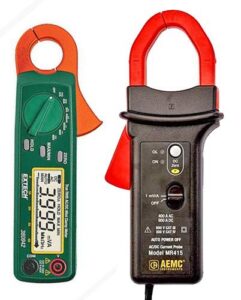 A few clamp meters, such as the Extech 380942 (left), employ the Hall technique for sensitivity with reduced jaw size. The AEMC MR416 (right) is an ac current probe for use with a DMM or oscilloscope. It uses the Hall method to provide a 30kHz bandwidth. Another accessory that can be used with a multimeter, panel meter or data logger is the AEMC 24-3001. It is a flexible Rogowski coil with a signal conditioning module that provides an AC mV output proportional to AC current. Portable oscilloscopes, power meters, energy meters, dataloggers and other instruments capable of ac measurements, also use an external clamp-on CT or Rogowski probe for each current input channel. The AEMC AL834 4-channel datalogger (bottom) uses four Rogowski coil flexible input probes.
A few clamp meters, such as the Extech 380942 (left), employ the Hall technique for sensitivity with reduced jaw size. The AEMC MR416 (right) is an ac current probe for use with a DMM or oscilloscope. It uses the Hall method to provide a 30kHz bandwidth. Another accessory that can be used with a multimeter, panel meter or data logger is the AEMC 24-3001. It is a flexible Rogowski coil with a signal conditioning module that provides an AC mV output proportional to AC current. Portable oscilloscopes, power meters, energy meters, dataloggers and other instruments capable of ac measurements, also use an external clamp-on CT or Rogowski probe for each current input channel. The AEMC AL834 4-channel datalogger (bottom) uses four Rogowski coil flexible input probes.
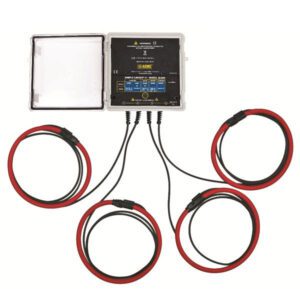 Remote Measurements
Remote Measurements
AC current transducers provide a convenient way to send a scaled and isolated analog signal to a meter, controller or other instrument located away from the circuit being measured. Another method to capture AC measurements remotely is to use an AC ammeter that has an analog output, such as the Weschler BG241 (left) or the Laurel L40 (right). 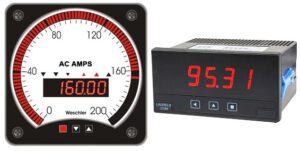 The meter provides a local readout and sends a proportional DC signal (typically 4-20mA) to another device for remote display, recording or further processing.
The meter provides a local readout and sends a proportional DC signal (typically 4-20mA) to another device for remote display, recording or further processing.
Digital communication can be used to send measurement data directly to a computer or network. The computer may be located close to the test point or remotely. Smart digital panel meters and portable instruments often include communication capability. The most common hardware interface for meters is serial RS-485. Ethernet allows an instrument to be accessed from other locations on the network. For local data transfer, USB is a 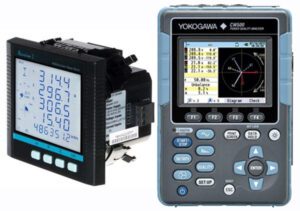 simple and convenient interface. Modbus RTU and Modbus TCP are popular general use protocols. Specialized protocols, such as Profibus, Canbus, BACnet, and LonWorks are sometimes used in certain industries or applications. The Accuenergy AcuVimII Power & Energy Meter (left) has RS-485 and Ethernet communication ports, with Modbus, Profibus, DNP3.0 and BACnet protocols. The Yokogawa CW500 Power Quality Analyzer (right) has a USB port for transfer of stored data and setups. A few portable instruments have wireless communication capability.
simple and convenient interface. Modbus RTU and Modbus TCP are popular general use protocols. Specialized protocols, such as Profibus, Canbus, BACnet, and LonWorks are sometimes used in certain industries or applications. The Accuenergy AcuVimII Power & Energy Meter (left) has RS-485 and Ethernet communication ports, with Modbus, Profibus, DNP3.0 and BACnet protocols. The Yokogawa CW500 Power Quality Analyzer (right) has a USB port for transfer of stored data and setups. A few portable instruments have wireless communication capability.
AC Measuring Instruments from Weschler Instruments
To begin the search for an AC ammeter, select the Ammeter category under Panel Meter products. For the ‘Select Input’ filter, choose ACA. Use a similar process to search for a DMM or Clamp Meter with AC current capability. Other filters on these web pages narrow the search based on output, communication or other parameters.
